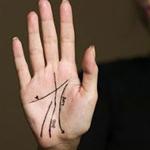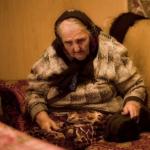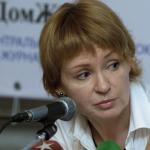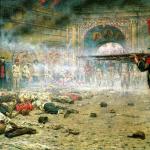Speaking about the state flag of Russia, one cannot help but remember that the first flag in Rus' was red. It was under it that the fighting squads of princes Oleg and Svyatoslav went on campaigns. At first, the red flag had an image of a bident, but with the adoption of Christianity it was replaced by a cross. In the era of fragmentation of lands, there were a great many banners, each principality had its own symbol.
The first attempt to raise a single, all-Russian flag was in September 1380. Then the Russian army united under a banner with the face of Christ. The Nikon Chronicle tells us that the prince marched against Mamaia under a crimson-red banner.
The banner of the “Most Merciful Savior” occupies a special place. Kazan was stormed under this banner, under Queen Sophia it took part in the Crimean campaigns, and under Peter I - in the Azov campaign and the Northern War with the Swedes.
But the familiar white-blue-red flag appeared at the behest of Tsar Alexei Mikhailovich as the banner for the first Russian warship - the frigate "Eagle", launched in 1668. The ship was built by the Dutch, and they were also tasked with coming up with a flag for it. They didn’t think for a long time and created it using their own stencils, only they changed the order of colors relative to their native, Dutch one. There was no task to somehow justify the choice of flag colors: the main thing was not to look like other banners and be visually different from them.
He became the main founder of our banner. The king himself drew a sample of the flag and determined the order of the horizontal stripes on it. And in January 1705, a corresponding decree was issued, according to which a white-blue-red flag was to be flown on all merchant ships. This flag also adorned the warships of the Russian fleet until 1712, and then the St. Andrew’s flag was introduced.

There is another flag in our history that appeared in 1858. And in 1865, Alexander II issued a personal decree, which stated that black, orange (gold) and white are the “state colors of Russia.” Later this flag received the name imperial. However, this symbol was never approved. It existed until 1883.
The appearance of the imperial flag created confusion. In 1883, during the coronation of the new Emperor Alexander III, the “dual power” ended. It was stated that only the red, blue and white flag should be used for decoration and on all official occasions.

At the same time, the three colors of the flag received an official interpretation. Red began to symbolize sovereignty, blue - the color of the Mother of God and white - the color of freedom and independence. In addition, the colors also symbolized the commonwealth of White, Little and Great Russia.
The Tsar's tricolor was rejected by the Soviet authorities. In April 1918, the red flag with a hammer and sickle was adopted as the state flag, which officially existed for 73 years.

On August 22, 1991, the Extraordinary Session of the Supreme Council of the RSFSR approved the tricolor flag as the official symbol of Russia, and by decree of the President of the Russian Federation B.N. Yeltsin dated December 11, 1993, the regulations on the state flag of the Russian Federation were approved.
Tell your friends about the news:
In contact with
Classmates
There is a lot of debate about the correct arrangement of colors on the flag of the Russian Empire. The imperial flag, as we are accustomed to seeing today, consists of an upper black stripe, a middle yellow stripe and a lower white stripe. In this form it was adopted in 1858. Which is correct: black-yellow-white or white-yellow-black?
It is with pleasure that I publish a study on the history of the Imperial Flag of Russia, which today has become one of the symbols of resistance to the liberal regime and the national liberation struggle.
From the article we understand that even this symbol was turned upside down through the efforts of Judeo-Protestants, who sought to distort the meanings as much as possible. Today in the national-patriotic movement it will be difficult to explain that for many years the symbol was used “with broken logic.” Meanwhile, we know how to turn the situation against those who tried to undermine Imperial symbols and national meanings.
An upside-down flag often symbolizes that a state is in a critical situation. The Philippines is the only country in the world where the flag is officially used in two versions - normal and inverted. The reverse position of the color stripes is used when the Philippines is at war or martial law is introduced in the country.
Today Russia is virtually occupied. So let the inverted flag emphasize our position. And we will return to the logical position of the colors of the Imperial tricolor when we achieve victory. After all, as Confucius said, “Signs and symbols rule the world, not words and rules.”
And now, the material of the article itself:
AND AGAIN ABOUT THE IMPERIAL FLAG... THE BATTLE FOR THE TRICOLORE
There are a lot of publications on this topic, mostly of an educational nature, where there is no justified explanation of how colors should be positioned correctly. There is only a reference to the highest approved decree No. 33289 of June 11, 1858 “On the arrangement of the coat of arms of the Empire on banners, flags and other items used for decoration on special occasions.” But the circumstances under which the decree was adopted, the current state situation and who was the author of this document are not indicated.
So until 1858 the flag was different. The order of the colors in it was as follows: starting from the top stripe - white, then yellow and black at the bottom. It existed in this form until its official adoption. Along with it, there was a white-blue-red one... But the white-yellow-black flag before Alexander II, and after that the black-yellow-white flag was perceived by society as an imperial, government flag, in contrast to the white-blue-red flag of the Russian merchant fleet. The imperial flag was associated in the minds of the people with ideas about the greatness and power of the state. It is clear that there can be something majestic in the trade flag, in its very colors, which were artificially tied to Russian culture by Peter I (who simply copied the colors of the Dutch flag).
Coexistence of the two flags until the 70s. XIX century was not so noticeable, but the question of the “duality” of the most important state Russian symbol is gradually beginning to arise. This duality is perceived differently by the Russian public. Ardent defenders of the Russian autocracy believed that there could be no talk of any flag other than the imperial one, legalized by the emperor: the people and the government must be united. The opposition to the tsarist regime stood under the trade flags of white, blue and red, which became a symbol of the anti-government political movements of those years. It was the “trade flag” that was defended by the so-called. “liberal” circles who shouted to the whole world that they were fighting the despotism and reactionary nature of the tsarist government, but, in fact, they were fighting against the greatness and prosperity of their own country.
During this heated controversy, Alexander II died at the hands of revolutionaries. His son and successor, Alexander III, on April 28, 1883, gave the white-blue-red flag the status of a state flag, but without abolishing the imperial one. Russia now has two official state flags, which further complicates the situation. And already on April 29, 1896, Emperor Nicholas II ordered that white-blue-red be considered the National and State flag, also indicating that “other flags should not be allowed.”

Black-yellow-white remained only with the imperial family. The emperor was “persuaded” because supposedly all Slavic peoples were assigned such colors - and this emphasizes their “unity”. And explaining this by the fact that the black-yellow-white flag “does not have heraldic historical foundations in Russia” to be considered a cloth bearing Russian national colors. This begs the question, what historical basis does the trade flag have?
But let's return to the white-yellow-black banner. That is, then, before adoption, the white-yellow-black flag was simply turned over.
The “coup” can also be traced to its author - Bernhard Karl Köhne (he will be discussed at the end of the article in order to fully understand what kind of person got involved in “correcting” Russian heraldry). Upon his accession to the throne, Alexander II decided, among other things, to put the state symbols in order - and to bring them into line with pan-European heraldic standards.
This was to be done by Baron Bernhard-Karl Köhne, who was appointed head of the stamp department in 1857. Köhne was born into the family of a secret state archivist, a Berlin Jew, a heretic who converted to the Reformed religion. He came to Russia under the patronage. In heraldic historiography he earned a sharp negative assessment, despite his vigorous activity.
But be that as it may, the flag was accepted and in this form it existed until 1910, when monarchists raised the question of the “correctness” of the flag, since the 300th anniversary of the House of Romanov was approaching.
A special meeting was formed to clarify the issue “about the state Russian national colors.” It worked for 5 years, and the majority of participants voted for the return of the imperial white-yellow-black flag with the “correct” arrangement of colors as the main, state flag.

For some reason and why, it is not clear, but they made a compromise - the result was a symbiosis of two competing flags: the eclectic white-blue-red flag had a yellow square with a black double-headed eagle in the upper corner. We fought a little with this one in the First World War. Further, the history of the imperial flag ends for a well-known reason.
In heraldry, an inverted flag means mourning, Köhne knew this very well, heading the heraldic department of the Empire. The death of the Russian emperors confirmed this. In maritime practice, an inverted flag means that the ship is in distress. It is clear that colors are still confused and flags are hung upside down, consciously and unconsciously, but for this to happen at the state level and with many years of struggle, special efforts of special people are needed.
The existence of the white-yellow-black flag is confirmed by newsreels, but they are treated differently due to the black and white film. Supporters of the black-yellow-white flag explain that on the set of the white-blue-red flag, without being embarrassed by the simple experience of comparing colors, when converting colored flags into black and white mode using any well-known graphic editor.
Also, the tricolor in the white-yellow-black arrangement can be seen in artists’ paintings.

In Vasnetsov’s painting dedicated to the Russian-Turkish war, a white-yellow-black flag is installed. Interesting fact: the painting dates back to 1878, that is, it was painted 20 years after the release of statement No. 33289 “about the arrangement of coat of arms flowers” in which they were changed in reverse. It turns out that the people still used uninverted white-yellow-black flags.
(In the center, either the (blue-yellow-red) flag of the United Principality of Wallachia and Moldavia, an ally of the Russian Empire in the Russian-Turkish War (1877-1878), or the Pan-Slavic (blue-white-red) flag - the difficulty of determining color reproduction middle zone. In 1848, at the Pan-Slavic Congress in Prague, the Slavic peoples adopted a common Pan-Slavic flag, repeating the colors of the Russian (white-blue-red) flag).

And here is Rozanov’s painting “Fair on Arbat Square”. White, yellow and black flags can be seen waving on the roofs of buildings. And along with them are white, blue and red. The picture was painted just during the coexistence of the two flags.
No matter how they explain the location of the black stripe at the top: this is the incomprehensibility of God (how is God light?), and the greatness of the Empire, and the color of Spirituality (referring to the monastic robe). Also interpreted as: black - monasticism, yellow - gold of icons, white - purity of the soul. But all this is from the category of popular interpretations “whoever comes up with it.”
At the same time, the most important point is missed, that the colors of the imperial flag should be identical to the words that express our entire Slavic essence: Orthodoxy, Autocracy, Nationality. Or to put it another way: Church, King, Kingdom. What color goes with each of these words? The answer is obvious.
In 1858, along with the flag, changes were made to the state emblem. Koehne created it the way we are used to seeing it. Although under Nicholas I it was different.

For example, the Coat of Arms depicted on coins.
Here are the Nikolaev coins, 1858



But the 1859 coin of Alexander II (the reign of Alexander II, whose years were nicknamed the “era of great reforms”), for Russian Jews, as well as for the country as a whole, was a sharp contrast to the previous period: reforms in the economy, relative political freedoms, rapid development industry - all this, like a century earlier in Prussia, created the conditions for Jewish assimilation, which never happened). Here you can clearly see how accurately the eagle was “licked” from the Habsburg coat of arms. A particularly striking detail is the eagle's tail. And all this in one year with the change of the flag. Magendovids (six-pointed stars) also appeared on coins. Since the Masons are great symbolists, they just wanted to add at least a drop of tar to our heraldry.
A few more coins for comparison:



Back in 1959, a commemorative coin and medal “Monument of Emperor Nicholas I on Horseback” was issued.
Magendavids are now so small that they can only be seen under a magnifying glass

The copper coins were updated, the design changed radically, the stars there are “Soviet” - pentacles.
The image below shows the similarity of the coat of arms that Koehne “composed” with the coat of arms of the Habsburgs.


For comparison:
1) The crown acquired a ribbon (more like a snake); before this, this ribbon had never been used in Russian heraldry;
2) Previously, the wings on all eagles had a lot of feathers, but now they began to absolutely copy the Habsburgs, even in design, between the large feathers and here and there, there are small feathers. At the same time, our eagle turned out to have 6 feathers, versus 7;
3) The combination of the coat of arms and the chain, although this arrangement was used earlier, but on all previous coins, the Order of the Holy Apostle Andrew the First-Called was clearly visible, now it is just a chain, like the Habsburgs themselves;
4) Tail. Everything is clear without comment.

Bernhard Karl (in Russia "Boris Vasilyevich") Köhne (4/16.7.1817, Berlin - 5.2.1886, Würzburg, Bavaria) was born into the family of a secret state archivist, a Berlin Jew who adopted the Reformed religion (Köhne himself and his son remained Protestants, despite the fact that they connected their lives with Russia, only his grandson became Orthodox).
He became interested in numismatics early and published his first work in this field (“Coinage of the City of Berlin”) at the age of 20, when he was still a student at a Berlin gymnasium. He was one of the active figures, and then the secretary of the Berlin Numismatic Society. In 1841–1846 supervised the publication of a journal on numismatics, sphragistics and heraldry.
Köhne met Russia in absentia back in the early 1840s. The famous numismatist Yakov Yakovlevich Reichel, who served in the Expedition for the procurement of state papers, the owner of one of the largest numismatic collections, drew attention to the young man, who soon became his assistant in collecting and “representative” in German numismatic circles. After completing his university course, Koehne came to St. Petersburg for the first time.
He returned to Berlin with a firm desire to enter the Russian service and applied for the then vacant chair of archeology at the St. Petersburg Academy of Sciences (which never happened). As a result of Reichel’s patronage, on March 27, 1845, Koehne was appointed assistant to the head of the First Department of the Imperial Hermitage (the First Department included collections of antiquities and coins, it was headed by the major numismatist Florian Antonovich Gilles) with the rank of collegiate assessor. By the end of his life, Koehne had risen to the rank of Privy Councilor (1876).
In St. Petersburg, Koehne developed a vigorous activity. The persistent desire to get into the Academy of Sciences, moreover, in the archaeological “direction”, stimulated not only his active study of archeology, but also his no less active organizational work. In an effort to gain the necessary weight in scientific circles, Koehne initiated the creation of a special numismatic society in Russia, but since archeology inevitably attracted him, he combined these two sciences under one “administrative” name - this is how the Archaeological-Numismatic Society appeared in St. Petersburg (later the Russian Archaeological Society ).
Köhne sought to promote himself and society on a European scale. It contained all the correspondence with foreign scientists. And foreign scientific societies invariably accepted him as their members, so that by the end of his life he was a member of 30 foreign societies and academies (he never got into the St. Petersburg one). By the way, the orientation towards the West led to the fact that Koehne tried not to allow reports in Russian at meetings (only in French and German), and only after the ethnographer and archaeologist Ivan Petrovich Sakharov (1807–1863) joined the society, the Russian language was restored to his rights.
The second half of the 1850s was Koehne’s “triumph” in Heraldry, when in 1856 he created the Great State Emblem of the Empire, and in June 1857 he became the manager of the Armorial Department at the department (with retention in office for the Hermitage). Having headed all practical work in the field of Russian heraldry, Koehne over the next years began a large-scale heraldic reform, trying to unify and give consistency to the body of Russian family and territorial coats of arms by bringing them into line with the rules of European heraldry (for example, turning the figures to the right heraldic side; replacing some that Koehne thought were not suitable for heraldry, figures for others, etc.) and the introduction of new principles and elements (placement of the provincial coat of arms in the free part of the city coat of arms, a system of emblems of the external part of territorial and city coats of arms, reflecting their status, etc. ).
Köhne’s career in the Russian Archaeological Society ended with the arrival of the new august leader, Grand Duke Konstantin Nikolaevich. He did not approve the election of Koehne as secretary of the third department of the society (the only case in the entire history of the society), as a result of which at the beginning of 1853 Koehne left its ranks. Konstantin Nikolaevich had a persistent dislike for Koena. In particular, he disapproved of the draft state emblem of 1856–1857.
On October 15, 1862, Köhne was allowed to accept the baronial title, granted on May 12/24 of the same year by the ruler (during the minority of Prince Henry XXII) of the Principality of Reuss-Greiz, Caroline Amalie. In the literature one can find a statement that Koehne owes this title to the state emblem of the Russian Empire he created, but this data needs confirmation. Most likely, the enterprising numismatist simply bought the rights to this title and thus became, probably, the only Baron “Reuss-Greizsky” in Russia.
At the same time, we can firmly state that Nicholas II and Tsarevich Alexei understood the problem of the state flag of the Russian Empire and intended to bring its colors to their original form, i.e. white-yellow-black. This is confirmed by the fact that the banner of the Livadia-Yalta amusement company named after Tsarevich Alexei consisted of white, yellow and black stripes.

In addition, for the 300th anniversary of the House of Romanov, Tsar Nicholas II approved an anniversary medal using the colors: White-Yellow-Black.
Well, this is another revealing lesson - already on state symbols - do not allow goats into the garden. But we already know how to turn this weapon against them.
7 7
If you notice an error, please select the required text and press Ctrl+Enter to inform the editor about it. Thank you!
Every person must know not only the past of his country, but also the history of the emergence of its main symbols of state power. In this article we would like to describe the Imperial, or People's Arms, black-yellow-white flag, whose it was, when it appeared and what it represented.
What is the meaning of the flag?
The banner of any country has a deep sacred meaning and succinctly expresses its identity. This official symbol of nationhood represents the nation by describing its spiritual reality. The flags depict important symbolic emblems, the coat of arms or its individual elements, which can conditionally tell about significant historical events, traditions, beliefs and even the economy and geographical location of the country. The colors of the banner always have a deep meaning, expressing the unity of the people, their power, and the desire for freedom and peace. The Russian black-yellow-white flag has become a sacred symbol of the Great Country, state power and strength, stability and inviolability of the historical borders of our Motherland. We will talk about it in detail below.
The history of the Russian flag. First national flag
State flags, like anthems, began to appear in European countries only from the end of the 18th century. Before this time, of course, there were various banners and coats of arms of aristocratic families, dynasties, merchant and military fleets, badges of guilds and workshops. Military banners and banners were common in Russia. They often depicted the faces of the Mother of God, the Savior and saints. They were sacred, like icons, and people often prayed and held prayer services in front of them. Royal banners were considered the banners of the state, but until the 17th century they did not have official status, so they often changed their appearance, colors and shape. It is believed that the emergence of the first Russian flag was started by Tsar Alexei Mikhailovich, who issued two special decrees in 1668-1669. They ordered that a white, blue and red banner be raised over Russian warships.

Flags from the reign of Peter I and Elizabeth Petrovna
Later, Peter I continued the work of creating a state banner. In 1693, on the warship "St. Peter" the "flag of the Tsar of Moscow" was raised, which was a panel (4.6 by 4.9 m) of horizontal stripes of blue, red and white. In the middle of the flag, a double-headed eagle was depicted in gold paint. In 1699, the Tsar himself drew a sketch of a three-stripe flag of the Russian Empire. In addition to the tricolor used on military ships, Peter I approved another state standard - a yellow cloth with a black eagle painted in the center, which held four maps with images of the Caspian, White and Azov seas, as well as the Gulf of Finland.

The next stage in the creation of the Russian state banner was the coronation procedure of Elizabeth Petrovna. For the ceremony (1742), a new banner of the Russian Empire was developed, consisting of a yellow cloth with the image of a black double-headed eagle, surrounded by oval shields with coats of arms.
Russian flag black, yellow, white - "imperka"
The next state flag was created for the coronation day of Alexander II. It looked like this: on a golden cloth a black eagle and a white St. George the Victorious were depicted on horseback. It was proposed to create such a flag by heraldist B.V. Köhne, who was involved in the development of the Romanov dynasty. He believed that for the new Russian national flag it was necessary to establish coat of arms colors - black, silver and gold, as this was accepted in the heraldry of many European countries. Later, on June 11, 1856, Alexander II, by his order, approved the new look of the State Flag and established from now on that all banners, standards, pennants and other items used on ceremonial occasions must have the coat of arms colors of the Russian Empire. This is how the black-yellow-white flag appeared in Russia. This tricolor began to be used on various special days, including the coronation of Alexander III. The black-yellow-white flag of the Russian Empire looked as shown in the following figure.

Subsequently, it began to be called the National Arms Flag. According to the government, ordinary people, contemplating the coat of arms on the state banner, became familiar with Russian culture and history.
What did the banner approved by Emperor Alexander II symbolize?
Each color of the flag - black, yellow, white - was deeply symbolic. Let's take a closer look at what they meant. double-headed eagle, showed imperial power, sovereignty, statehood, strength and stability. He pointed to the inviolability of the borders of the Russian Empire, stretching from the Pacific Ocean to the Pacific Ocean. He signified the strength and power of a huge country. The color gold (or yellow) was also of great importance. In the past, it was the main color of the banner of Orthodox Byzantium and was perceived by the Russian people as a symbol of spirituality and religiosity. symbolized the desire for moral development, improvement, as well as fortitude. It signified the preservation of the purity of the Orthodox faith and the comprehension of Divine truth.

White color symbolized purity and eternity. For the Russian people, it was a reflection of the deeds of St. George the Victorious and meant the desire to defend their homeland and preserve the Russian land, even sacrificing themselves. The white color spoke of the enormous strength of spirit of the Russian national character, the stamina and steadfastness of the defenders of the Russian land. Orthodoxy, autocratic power and nationality - this is what the Imperial black, yellow and white flag symbolized. Its significance is difficult to overestimate - it has become an expression of the Russian Orthodox tradition, autocratic power and the resilience of the common people.
Which flag: black, yellow, white or Peter's tricolor was used at the end of the 19th century?
Despite the fact that the new Russian flag, black-yellow-white, was created on the basis of the state emblem colors, which carried a significant sacred meaning, it was perceived by society exclusively as a government standard. Many Russian people associated black and yellow colors with Austria and the House of Habsburg. But the “Peter’s” white-blue-red tricolor was closer to the people and was considered civilian, gradually acquiring the status of “philistine”. Therefore, in the 70s - 80s. XIX in the Russian Empire there was a so-called “duality” of the state symbol.

At the same time, two banners existed and were used - the white-yellow-black flag of Russia (the government) and the national, white-blue-red tricolor. Often the latter was preferred - it appeared on city streets, was installed near monuments and was used at special events.
"Petrovsky" tricolor - the national flag of the Russian Empire
During the coronation, Alexander III was surprised that the Kremlin itself and the ceremonial procession were decorated in coat of arms, and the capital was decorated. Subsequently, the emperor signed a decree according to which the “Petrine” tricolor acquired official status and became the national flag of the Russian Empire. From the moment the resolution came into force, the flag “black, white, yellow stripe” began to be considered the banner of the reigning house of the Romanovs. Emperor Nicholas II, by his decree of 1896, secured the position of the white-blue-red banner as the only state one.

Return of the black-yellow-white flag
The approach of an important date - the 300th anniversary of the reign of the House of Romanov, as well as the bourgeois-democratic revolution caused a turn in politics regarding national colors. Adherents of the monarchical foundations wanted to return the “black, yellow, white stripe” flag, which for them was a symbol of the protection of the Russian Empire from future dramatic events. In 1914, an attempt was made to combine two flags - the “Petrine” tricolor and the black, white and yellow “Imperial” flag. As a result, a new banner appeared, in which there were colors - blue, black, red, yellow, white. The flag looked like this: in the upper rectangular fabric there was a yellow square. It featured a black double-headed eagle.

This combination was supposed to express the unity of the people and the authorities, as well as patriotism and faith in victory. Nevertheless, such an eclectic flag did not take root and did not become national. It served as an official state symbol for a short time - until 1917. The subsequent abdication of Nicholas II, and then the February Revolution, put an end to the introduction of imperial symbols.
Red flag of the USSR
After the October Revolution, the state flag acquired a new look: it was a simple red rectangular panel without inscriptions or any emblems. It became a symbol of Freedom and marked the advent of a new era in the life of the country. On April 8, 1918, at the meeting, a proposal was made to approve as an official red flag with the letters “P.V.S.S.”, denoting the famous motto calling for the unification of the proletarians of all countries. Further, in April 1918, a red banner with the inscription: “Russian Soviet Federative Socialist Republic” was recognized as the state flag.

Since the unification of the RSFSR with the BSSR, Ukrainian SSR and the Transcaucasian Federation in the USSR, the flag has become a scarlet rectangular cloth. It depicted a golden sickle and hammer in the upper corner, and above them a five-pointed red star with a gold border.
Use of the white-blue-red flag
From 1923 to 1991 This flag was recognized as official. Nevertheless, the "Petrine" tricolor continued to be used in some cases.

During the Great Patriotic War, he, along with the St. Andrew's flag, served some anti-Soviet formations. For example, the Russian Liberation Army under the leadership of Lieutenant General A. A. Vlasov used a slightly modified St. Andrew's flag with a red stripe along the edge. Let us note that the use of Russian national symbols was generally accepted in the collaborationist formations of the Third Reich. Later in the 70s. white-blue-red colors were used in the anti-communist organization - VSKHSON. In 1987, the “Petrine” tricolor began to be used by various patriotic groups, for example, the “Memory” society. In 1989, the mass democratic movement adopted the tricolor as its official symbol. At the same time, monarchists and followers of conservative movements began to again use the black, yellow and white flag of Imperial Russia. In 1989, the Patriotic Association "Russian Banner" made a proposal to abolish the red flag and once again make the white-blue-red banner official. The Supreme Council of the RSFSR decided (08.22.91) to recognize the white-blue-red tricolor as the official symbol of the state. On November 1, 1991, it was adopted as the state flag of the RSFSR.

The symbolic meaning of the white, blue and red colors of the modern Russian flag
These days there are several interpretations of the colors of the Russian flag. Since ancient times, white has stood for frankness and nobility, blue for honesty, chastity, fidelity and impeccability, and red for love, generosity, courage and courage. Another common interpretation was the correlation of colors with the historical territories of Russia. Thus, white was associated with White, blue with Lesser Russia, and red with Great Russia, symbolizing the unification of three peoples - Little Russians, Great Russians and Belarusians. There were other interpretations of color symbolism. For example, white color was considered as a symbol of Freedom, red - sovereignty, and blue - denoted the Mother of God. Sometimes, the colors of the “Petrine” tricolor were interpreted as a trinity of royal power, the Orthodox faith and the Russian people.
Instead of a conclusion
So, in this article we looked at the black-yellow-white flag: whose it was, when it arose and what it represented. We learned how Russian banners changed over time and what they represented. We described not only the “Petrine” banner, but also the red flag of the USSR. And, of course, they told us when the white-blue-red tricolor was adopted as the main state symbol of the Russian Federation.
The imperial flag is a three-color canvas with horizontally arranged colors (from top to bottom) - black, yellow and white.
Russian imperial flag of the Romanovs
Imperial flag meaning of colors
From the official description of the imperial flags it follows that the yellow and black stripes are identical to the state coat of arms (black eagle). White - to the silver rider, i.e. St. George the Victorious. However, each of the colors also has its own meaning:
- Black color denotes state stability, autocracy, the strength of the state and the inviolability of its borders;
- Yellow (gold color) is an allusion to the Byzantine Empire, in whose banners the color gold predominated. In addition, the semantic load of color in spirituality and the desire for self-improvement, fortitude;
- White (or silver) color The meaning is the same for almost all nations and means purity and eternity. The special meaning of white color for Russia is associated with St. George the Victorious, i.e. image of a selfless and sacrificial struggle for the Fatherland.
Special attention is paid to the location of the stripes on the imperial flag. The meaning of colors was deciphered differently, depending on the order of their alternation. So, until 1858 the stripes were reversed.
The color black was interpreted as the Russian people, the basis of autocracy and Orthodoxy. The white stripe denoted Orthodoxy and the church, and the yellow stripe, respectively, the sovereign and the power of the state. Thus, the colors of the cloth symbolized the heraldic meaning of what the imperial flag of Russia means: “Orthodoxy, Autocracy, Nationality.”
Why in 1858 this symbol was turned upside down and the traditional color order was disrupted is still unclear. In heraldry, an inverted flag is interpreted as a symbol of mourning.
By state decree, the black-yellow-white flag with the coat of arms was called the “Armoral People's Flag”.
History of the monarchical banner of Russia
The appearance of the Romanov imperial flag
For the first time, the monarchical flag of Russia appeared under Alexei Mikhailovich - the red-blue-white tricolor was used in the construction of the ship "Eagle". However, Peter I began to actively introduce such a banner into use. The imperial standard was also used under him.

 Imperial Russian flag, used since the time of Peter I
Imperial Russian flag, used since the time of Peter I The appearance of the canonical imperial image dates back to the middle of the 18th century. During the reign of Anna Ioanovna, the Senate issued a decree according to which individual troops (for example, dragoon regiments) were required to use scarves and headdresses that repeated the colors and symbols of the coat of arms of the Russian Empire.
Under Elizaveta Petrovna, the state imperial flag of Russia was made. History shows that the cloth of that time resembled a banner: the country’s coat of arms was located on a golden background, and along the edges were the coats of arms of various principalities and lands of the Russian Empire.
 Russian imperial flag from the time of Elizabeth Petrovna
Russian imperial flag from the time of Elizabeth Petrovna Approval of the tricolor in the 19th century
The black-yellow-white combination on various cockades, elements of clothing and buildings is increasingly used in the 19th century, especially during the Patriotic War. A little later, symbols began to be used on Zholner badges with the numbers of battalions in the regiment.
Under Nicholas I, these colors were actively used by civil servants, and under Alexander II, a real heraldic reform began, aimed at streamlining state symbols. The Emperor changed the small state emblem and made serious changes to the medium and large emblem of the Empire.
on this day Alexander II approved the flag
In fact, the imperial tricolor existed before this, but had a different arrangement of colors, namely from top to bottom - white, yellow, black.


In addition, in international trade the tricolor from the time of Peter I was used, which was considered a Russian state symbol abroad. In fact, several flags were installed in the second half of the 19th century. And the emperor’s decree, according to which the new imperial banner was to become the “flag of the national Russian cockade,” did not bring adequate clarity.
Despite the approval, the imperial flag never received status.
Therefore, in historiography there are various references to it - from the Romanov flag to the flag of imperial colors.
Contemporaries perceived the symbols and colors of the imperial flag as governmental and state, in contrast to the so-called. trade flag of Russia (white-blue-red flag with a double-headed eagle).
The trade flag could instill peace and a desire for something new, while the imperial flag personified menacing and strength, historical destiny and eternity. During the active use (1858-1883) of the new version, the Russian state did not lose a single war, carried out a number of successful reforms, and recovered from the Crimean War.
That is why the decision of Alexander III to give official status to the Peter the Great tricolor caused a mixed reaction in society. However, even after this decision, the imperial flag was used in many lands of the state, and was used at official ceremonies of the emperor's family.
Imperial flag today
Currently, imperial flags are widely used in nationalist circles, football fans, and other organizations (mainly monarchical or patriotic). Modern monarchists and nationalists widely celebrate the date of the official adoption of the imperial flag ( June 24 according to the new style).
day of official approval of the imperial flag
In this regard, the flag of nationalism is perceived ambiguously in society and is even subject to “persecution.” For example, a black-yellow-white flag with a coat of arms is prohibited for use in the stands of RFPL matches.
The historical fate of the flag remains unclear. In addition to its active use by right-wing forces, it was also noticed by defenders of the Supreme Council of the Russian Federation. On the other hand, in 1991, opponents of the State Emergency Committee also took to the streets with this banner.
So, in 2014, an appeal was submitted to the State Duma with a request to grant him a special status. They are actively trying to make the imperial tricolor - a white-blue-red flag with an eagle - the official colors of Novorossiya.
Despite all the contradictions and how the colors of the imperial flag of Russia are interpreted, the significance of this symbol for Russian history should be recognized. And despite its active use by right-wing organizations, the flag is not included in the list of extremist symbols.
At first I thought that maybe it was a white-blue-red flag? But then I read that: “The WFTU had its own party flag. According to Regulation No. 71 “On the Party Flag of the W.F.P.”, it was a banner with a black swastika on a yellow background of a diamond in a white rectangle.” Therefore, most likely in the photo on the left it is the white-gold-black flag. But this is just a guess.
What is beyond doubt?
Recently, one of my close comrades, monarchists by conviction, stubbornly argued that it is impossible for nationalists, and especially monarchists, to use a flag with white at the top, this violates the Laws of the Russian Empire. My logical arguments are that using the Nationalist Organizations, essentially an association of private individuals, the state flag as their own, the flag of the Organizations, is the same as starting to rivet and issue, for example, St. George’s crosses in their own name, i.e. profanation. The state flag should be owned by the STATE, and not by organizations, even if they strive to restore this state. But all my arguments were in vain, I was branded a scoundrel. My call to look at the photographs and make sure that WHITE UP is the flag of the RUSSIAN MILITARY in the Russian Empire, and the flag of the RUSSIAN NATIONALISTS both in the Russian Empire and after - went unheard. And the person is still confident that everyone who overturns the state. flag of the Republic of Ingushetia - they are scoundrels, almost criminals, and perhaps unconscious agents of the Judeo-Masons.
But I hope you, my reader, are not blind, and can see what you see below.
Let's look at the flag from the museum, in the photo - the flag of one of the military units of the Russian Empire ( " And they had exactly the same banner as in all the regiments of the Russian Empire") , pay attention to the year:
As one researcher writes:
"To summarize...Whether the flag is placed black or white up depends on whether the flag you raise is the flag of a military unit or a government agency."
What is closer to the nationalists who fight for their Motherland? The answer is obvious.
I refer the most distrustful to the elder the white-emigrant monarchist newspaper of the Russian Abroad “Our Country”, which on its website arranges the colors (from top to bottom): white-yellow-black and states: “That’s right - a white stripe at the top, black at the bottom, gold in the middle. But on the contrary, this is a distortion. " http://nashastrana.net/wp-content/uploads/2012/05/NS-2963-M.pdf (at the end of the last page).
I will also quote another author:
"For people who do not know the history of the Russian flag, I suggest they go to the Museum of Modern History and see with their own eyes what flag was used by the Black Hundred, monarchist and Russian national organizations in the Russian Empire. A short excursion for those who doubt it:
But by the way, the banner of the UNION OF THE RUSSIAN PEOPLE is not black, gold and white at all...
Museum address:
125009, Russia, Moscow, Tverskaya st., building 21."
But I have to return to this topic again, because... Until now, the truthful information about the legality of “WHITE UP” has not yet been realized by everyone.
Those who doubt it, be sure to read it.
The following interesting fact should be added to what is stated there:
"And so, “for a comprehensive and, if possible, final clarification of the issue of state Russian national colors,” a new Special Meeting was formed at the Ministry of Justice in May 1910, chaired by Comrade (Deputy) Minister of Justice A. N. Verevkin. In addition to officials from various departments, it was attended by specialists in heraldry, numismatics, and archival affairs: ....
Each of the scientists, to the best of their professional knowledge and based on their own political convictions, left their opinion on this issue in published form. In 1915, its active participant P.I. Belavenets reported the following about the results of the Special Meeting: the votes of the meeting participants were divided; the majority was in favor of introducing a “new flag according to the coat of arms” as a common flag, but “upside down, that is, the result would be a white-yellow-black flag.” P.I. Belavenets himself and a number of members of the Conference who joined him categorically insisted on a white-blue-red flag. The arguments of both sides seemed so convincing that “the conclusion reached was not worthy of the Highest final decision.” The conclusion was transferred to the Council of Ministers, the latter handed it over to the “Special Interdepartmental Commission at the Ministry of the Navy” for additional consideration." That is, the choice was between white-gold-black and white-blue-red. They did not have time to resolve this issue. The Russian Empire ceased to exist."
The conclusions are clear to anyone who takes 10 minutes to read it.
Those who use it with a black stripe up are right, and those who use it with a white stripe up are also right.
“WHITE UP” is a combat version of the Russian flag (it did not manage to become the state flag), and in my humble opinion, it is more relevant for those who believe, like Russian nationalists of the past and White emigrants, that the Russian war for their country is not over and continues.
Vladimir Basmanov










![Vladimir Abarinov [...] The FSB has an ideal opportunity to really seriously distinguish itself in the field of combating the illegal arms trade. Viktor Bout lives in Russia, hiding from no one... Vladimir Abarinov [...] The FSB has an ideal opportunity to really seriously distinguish itself in the field of combating the illegal arms trade. Viktor Bout lives in Russia, hiding from no one...](/uploads/31b616da6c02c8c4d2816d11561bdc19.jpg)







